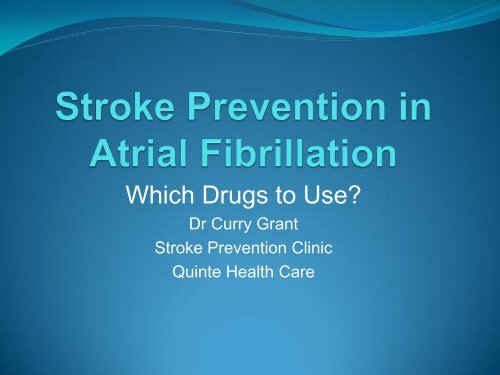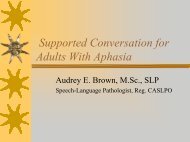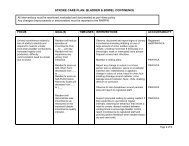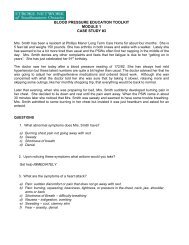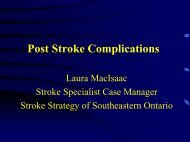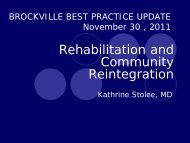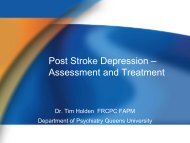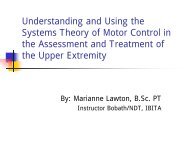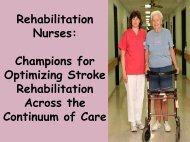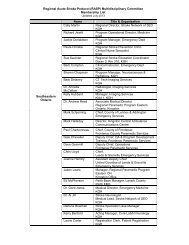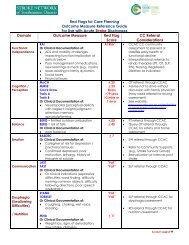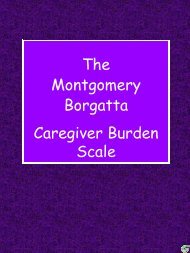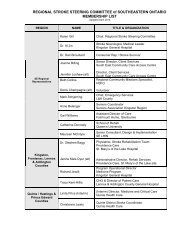Atrial Fibrillation - The Stroke Network of Southeastern Ontario
Atrial Fibrillation - The Stroke Network of Southeastern Ontario
Atrial Fibrillation - The Stroke Network of Southeastern Ontario
You also want an ePaper? Increase the reach of your titles
YUMPU automatically turns print PDFs into web optimized ePapers that Google loves.
Which Drugs to Use<br />
Dr Curry Grant<br />
<strong>Stroke</strong> Prevention Clinic<br />
Quinte Health Care
Disclosure <strong>of</strong> Potential for<br />
Conflict <strong>of</strong> Interest<br />
Dr. F.C. Grant<br />
<strong>Atrial</strong> <strong>Fibrillation</strong><br />
FINANCIAL DISCLOSURE:<br />
Support provided by the <strong>Stroke</strong> <strong>Network</strong> <strong>of</strong> <strong>Southeastern</strong> <strong>Ontario</strong><br />
Other: None
Objectives<br />
• Review importance <strong>of</strong> atrial fibrillation in causing<br />
stroke<br />
• Assessing the risk <strong>of</strong> embolic stroke<br />
• Assessing the risk <strong>of</strong> bleeding<br />
• Choosing the best drug for your patient
Causes <strong>of</strong> Ischemic <strong>Stroke</strong><br />
• Large artery atherosclerosis 30%<br />
• Cardioembolic <strong>Stroke</strong> 25-35%<br />
• Small vessel disease 25%<br />
• Unknown 20%<br />
• Unusual causes 5%
Importance <strong>of</strong> <strong>Atrial</strong> <strong>Fibrillation</strong><br />
• ¼ <strong>of</strong> patients over 40 will eventually develop atrial<br />
fibrillation<br />
• Risk <strong>of</strong> stroke averages 5% per year<br />
• Antithrombotic therapy reduces the risk <strong>of</strong> death by<br />
¼ and stroke by 2/3<br />
• Embolic strokes due to atrial fibrillation tend to be<br />
large and to have a high mortality
Approach to <strong>Atrial</strong> <strong>Fibrillation</strong><br />
1. Assess the risk <strong>of</strong> stroke using the CHADS2 Score<br />
2. Assess the risk <strong>of</strong> bleeding using the HAS BLED<br />
Score<br />
3. Possible Choices:<br />
1. Aspirin<br />
2. Aspirin plus clopidogrel<br />
3. Warfarin, apixaban, dabigatran or rivaroxaban<br />
4. Combination antiplatelet plus antithrombotic
Assessing the Risk <strong>of</strong> <strong>Stroke</strong><br />
CHADS2 Score for patients in atrial fibrillation<br />
Risk Factor<br />
Score<br />
Cardiac Failure 1<br />
Hypertension 1<br />
Age 75 or over 1<br />
Diabetes 1<br />
<strong>Stroke</strong> or TIA 2
Annual Risk <strong>of</strong> <strong>Stroke</strong><br />
CHADS2 Score Annual Risk %<br />
0 1.9<br />
1 2.8<br />
2 4.0<br />
3 5.9<br />
4 8.5<br />
5 12.5<br />
6 18.2<br />
0=Very Low Risk<br />
1=Moderate risk<br />
2 or more = Moderate to High Risk
HAS BLED Risk Factors<br />
Risk <strong>of</strong> Bleeding<br />
on Treatment<br />
Hypertension 1<br />
Abnormal kidney or liver function<br />
<strong>Stroke</strong> 1<br />
Bleeding History 1<br />
Labile INRs 1<br />
Elderly Over 65 years 1<br />
Drugs (antiplatelet or NSAID) or<br />
alcohol abuse<br />
Points<br />
1 or 2. One point for each.<br />
Maximum 9 points Low Risk 2 or fewer, High Risk 3 or more<br />
1
HAS BLED Risk Factors<br />
Risk <strong>of</strong> Bleeding<br />
Hypertension 1<br />
Abnormal kidney or liver function<br />
<strong>Stroke</strong> 1<br />
Bleeding History 1<br />
Labile INRs 1<br />
Elderly Over 65 years 1<br />
Drugs (antiplatelet or NSAID) or<br />
alcohol abuse<br />
Points<br />
1 or 2. One point for each.<br />
Maximum 9 points Low Risk 2 or fewer, High Risk 3 or more<br />
1
<strong>The</strong>rapies to Prevent <strong>Stroke</strong><br />
• Antiplatelet Drugs: aspirin, clopidogrel (Plavix),<br />
• Oral Anticoagulant Drugs<br />
• Vitamin K antagonist: warfarin (Coumadin)<br />
• Direct Thrombin Inhibitor: dabigatran (Pradax)<br />
• Factor X inhibitors:<br />
• apixaban (Eliquis)<br />
• rivaroxaban (Xarelto)<br />
• Combinations <strong>of</strong> the above
Drug(s)<br />
Risk <strong>of</strong> Bleeding with A Fib-<br />
Danish Population Study<br />
Annual Risk <strong>of</strong> Bleeding % per<br />
year<br />
ASA alone 3.7<br />
Warfarin 3.9<br />
Clopidogrel 5.6<br />
ASA + Clopidogrel 7.4<br />
Warfarin + Aspirin 6.8<br />
Warfarin + Clopidogrel 13.9<br />
Warfarin + Clopidogrel + Aspirin 15.7
Bleeding on Warfarin ICES<br />
• In patients over 65 years with atrial fibrillation on<br />
warfarin the overall bleeding rate was 3.8% per year<br />
• Highest rates were within the first 30 days<br />
• Increased rates with CHADS2 = 4 or higher<br />
• Mortality from bleeding 18%<br />
• CMAJ 2013 185(2) E121-127
Canadian Cardiovascular Society<br />
• Low risk (CHADS 2 =0)<br />
2012 Guidelines<br />
• No drug, aspirin or oral anticoagulant according to additional risk<br />
factors<br />
• Moderate Risk (CHADS 2 =1)<br />
• Apixaban, dabigatran and rivaroxaban are preferred over warfarin<br />
• Aspirin is an option for some<br />
• High Risk CHADS 2 > 2<br />
• Apixaban<br />
• Dabigatran<br />
• Rivaroxaban<br />
• Warfarin
Apixaban, Dabigatran and<br />
Rivaroxaban<br />
• Approved for non-valvular atrial fibrillation (not for prosthetic valves<br />
or rheumatic heart disease)<br />
• Estimated glomerular filtration rate (eGFR) must be over 30 ml/min.<br />
• Need to monitor renal function periodically<br />
• Caution with previous GI bleeding or coronary heart disease<br />
• Apixaban dose 5 mg BID<br />
• Dabigatran usual dose 150 mg. BID. Reduce to 110 mg. BID with<br />
moderate renal impairment, elderly or small body size.<br />
• Rivaroxaban usual dose 20 mg. daily or 15 mg daily with impaired<br />
renal function
Pharmacology<br />
Drug Dabigatran Apixaban Rivaroxaban<br />
Action Thrombin Xa Xa<br />
T ½ 12-14 hours 12 hours 7-11 hours<br />
Dose 110 or 150<br />
mg. BID<br />
Renal<br />
Excretion<br />
5 mg. BID 15 or 20 mg<br />
OD<br />
80% 25% 33%<br />
Bioavailability 6% 60% 80%<br />
Prodrug Yes No No<br />
Interactions P-gp 3A4 3A4/P-gp
Clinical Trials<br />
Drug Dabigatran Apixaban Rivaroxaban<br />
Trial RE-LY ARISTOTLE ROCKET-AF<br />
Design<br />
Open-Label<br />
Warfarin<br />
Double-Blind<br />
Double-Blind<br />
Participants 18,113 18,206 14,264<br />
A F Risk<br />
Factors<br />
1 or more 1 or more <strong>Stroke</strong>, 2 or<br />
more<br />
Warfarin Naïve 50% 43% 38%<br />
% Time INR<br />
2-3<br />
64 62.2 55
Comparison with Warfarin<br />
Ischemic<br />
<strong>Stroke</strong><br />
Hemorrhagic<br />
<strong>Stroke</strong><br />
Dabigatran Apixaban Rivaroxaban<br />
Better Same Same<br />
Better Better Better<br />
Major Bleed Same Better Same<br />
Mortality Same Better Same
What your patients need to know about<br />
novel oral anticoagulants<br />
1. Compliance is essential. Forgetting 2 or more doses will<br />
leave them unprotected.<br />
2. <strong>The</strong>re is no antidote. If serious bleeding occurs, only<br />
supportive treatment is available at present.<br />
3. If they are on warfarin with a well-controlled INR there is no<br />
need to switch to dabigatran.<br />
4. <strong>The</strong>y should avoid ASA and NSAIDs while on antithrombotic<br />
agents due to the increased risk <strong>of</strong> bleeding.<br />
5. <strong>The</strong>y need renal function tested annually or during acute<br />
illnesses that could impair renal function (creatinine and<br />
eGFR).<br />
6. If not on ODB, the cost is about $100/month.
Dabigatran (431) and Rivaroxaban (435)<br />
ODB Limited Use Criteria<br />
• Inclusion Criteria<br />
• Non-valvular atrial fibrillation CHADS2 = 1 or more<br />
• Inadequate anticoagulation after a trial <strong>of</strong> at least 2<br />
months on warfarin<br />
• Or: warfarin contra-indicated or unable to monitor<br />
INR<br />
• Exclusions:<br />
• eGFR under 30 ml./min.<br />
• Hemodynamically significant valvular heart disease<br />
or prosthetic heart valve
When should warfarin still be used in atrial<br />
fibrillation patients<br />
1. Valvular heart disease<br />
2. Kidney disease with eGFR < 30 ml./min<br />
3. Patients stable on warfarin<br />
4. Patients who cannot afford $3.00 per day<br />
5. Patients on ODB who do not meet criteria<br />
6. Patients in whom the lack <strong>of</strong> an antidote is a<br />
consideration<br />
7. Significant side effects on dabigatran or<br />
rivaroxaban
Case Example<br />
• A 75 year-old lady has had gradually-worsening<br />
fatigue and intermittent palpitations.<br />
• Past history <strong>of</strong> Type 2 DM, hypertension and a nondisabling<br />
stroke<br />
• Meds: ASA, perindopril, HCTZ, metformin<br />
• Physical exam: Pulse 100/min. irregular, BP 140/90<br />
• Lab: eGFR 90 ml./min.<br />
• CHADS2 =<br />
• HAS BLED =
Case Example<br />
• A 75 year-old lady has had gradually-worsening fatigue<br />
and intermittent palpitations.<br />
• Past history <strong>of</strong> Type 2 DM, hypertension and a nondisabling<br />
stroke<br />
• Meds: ASA, perindopril, HCTZ, metformin<br />
• Physical exam: Pulse 100/min. irregular, BP 140/90<br />
• Lab: eGFR 90 ml./min.<br />
• CHADS2 = Hypertension 1 + Elderly 1 + DM 1 + <strong>Stroke</strong> 2<br />
= 5<br />
• HAS BLED= Hypertension 1 + Elderly 1 + <strong>Stroke</strong> 1 = 3
• Warfarin<br />
• Apixaban<br />
• Dabigatran<br />
• Rivaroxaban<br />
Treatment Choices<br />
• ASA + Clopidogrel (for patients who are not<br />
candidates for warfarin, apixaban, dabigatran or<br />
rivaroxaban)<br />
• NB Same bleeding risk as warfarin.
Resources<br />
• Decision Aid by Stephen LaHaye and colleagues at<br />
www.afib.ca and iPad App Afib CDA ($4.99)<br />
• Canadian Cardiovascular Society Guidelines at<br />
www.ccs.ca and iPad App CCS <strong>Atrial</strong> <strong>Fibrillation</strong><br />
Guidelines (Free)<br />
• Canadian Best Practices for <strong>Stroke</strong> Care<br />
www.strokebestpractices.ca
Questions
Ischemic<br />
<strong>Stroke</strong> %<br />
/year<br />
Appendix: Trial Results<br />
Drug vs (Warfarin)<br />
Dabigatran Apixaban Rivaroxaban<br />
.92 (1.2)* .97 (1.05) NS 1.34 (1.42)<br />
NS<br />
Hem. <strong>Stroke</strong> .10 (.38)* .24 (.47)* .26 (.44)*<br />
Major Bleed 3.11 (3.36)<br />
NS<br />
Mortality 3.64 (4.13)<br />
NS<br />
2.13 (3.09)* 3.6 (3.4) NS<br />
3.52 (3.94)* 1.87<br />
(2.21)NS<br />
All Rates are % per year. * = significant. NS=not significant<br />
at .05


